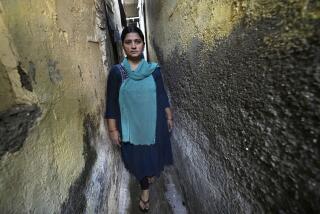ECONOMICS : A Lofty Goal: Ending India’s Worst Poverty by Year 2000
- Share via
NEW DELHI — The sweating Calcutta rickshaw wallah, the impoverished Bihari sharecropper and millions of other Indians struggling to get by were not consulted about it. But in the long run, they are meant to be the chief beneficiaries.
In announcing India’s 1994-95 budget this week, and disclosing the next moves in the government’s economic reform game plan, Finance Minister Manmohan Singh spoke in detail of tax reform, revenue projections and the need to give stagnating industry a helpful push.
But his first thought, the mild-mannered Oxford Ph.D. said later, was for the neediest.
For only through growth--enlarging the size of the macroeconomic pie--can the grinding indigence that blights life for countless Indians be eradicated, Singh said.
With sufficient growth, say 6% annually, India can abolish “extreme poverty” by the year 2000, he predicted.
That rosy forecast, a parting of the ways with the longtime official conviction that an end to misery could be engineered by government regulation and state planning, sounds much like “trickle-down economics”--and it is, at least of a kind, Singh acknowledged to foreign reporters at a dinner given in his honor.
It’s supposed to work this way:
Indian industry, which grew fat for decades on a domestic market protected from outside competitors by high tariff walls, is in the gradual process of becoming much freer from government control and more export-oriented.
As Indian companies find a niche in the global marketplace, that should create more jobs.
Allowing those entrepreneurs to build a richer India and continuing to court foreign investment will produce a broader revenue base to pay for a more secure social safety net. That will ignite a “ray of hope” of a better life in a nation where yearly income averages $330.
To coax India’s economy into expanding, the former university professor announced this week to Parliament that he is ready to take a risk that some fellow economists find audacious, even rash.
Singh wants to spend so much more than the government takes in over the coming 12 months that the fiscal deficit is projected to hit $17.8 billion, or 6% of gross domestic product.
His proposed reductions in excise taxes and customs tariffs and breaks on corporate and capital-gains taxes that will produce a steep drop in government revenue are meant mainly to revive Indian industry, which has been in the doldrums.
Once factories are working full tilt, the hope is that they will import more goods and refill government coffers, because about 40% of total revenue comes from fees on imports.
Higher output will also mean greater receipts from excise taxes, and more funds to spend on health, education and other basic services.
Such is the essence of what one Calcutta newspaper called Singh’s “big gamble.”
It all must seem unfathomable to a needy person, for whom the main discernible impact of the minister’s recent decisions has been an increase in the state-controlled price of bottled cooking gas and other staples.
Predictably, a leader of the opposition Bharatiya Janata Party called Singh’s $49-billion budget nothing but a prettily wrapped “sweet of cow dung.”
But parliamentary opponents of the ruling Congress-I Party mostly listened in respectful silence to Singh and offered no coherent counter-plan.
Free marketeers, on the other hand, expected more and were disappointed that Singh had not gone further.
Some critics were irked by the willingness of the finance minister, a professed apostle of fiscal “rectitude,” to spend beyond the government’s means.
Because Singh was a full 2.6% off in his 1993-94 calculations of the fiscal deficit and the GDP, those critics fear that the government is on the verge of losing control over spending.
Defending his proposals, which must still be enacted by Parliament, the minister stressed that reform in India can only garner continued citizen support if it has a “human face”--meaning that it is slow and in small doses.
“Given the right climate, India can surprise itself and the rest of the world,” he said. “India has the potential to be among the top five or six economic players in the world.”
More to Read
Sign up for Essential California
The most important California stories and recommendations in your inbox every morning.
You may occasionally receive promotional content from the Los Angeles Times.













